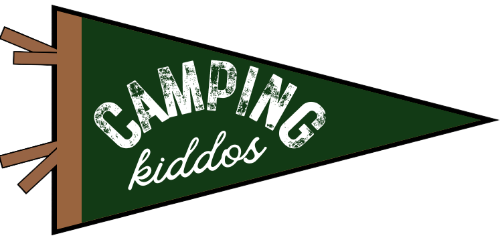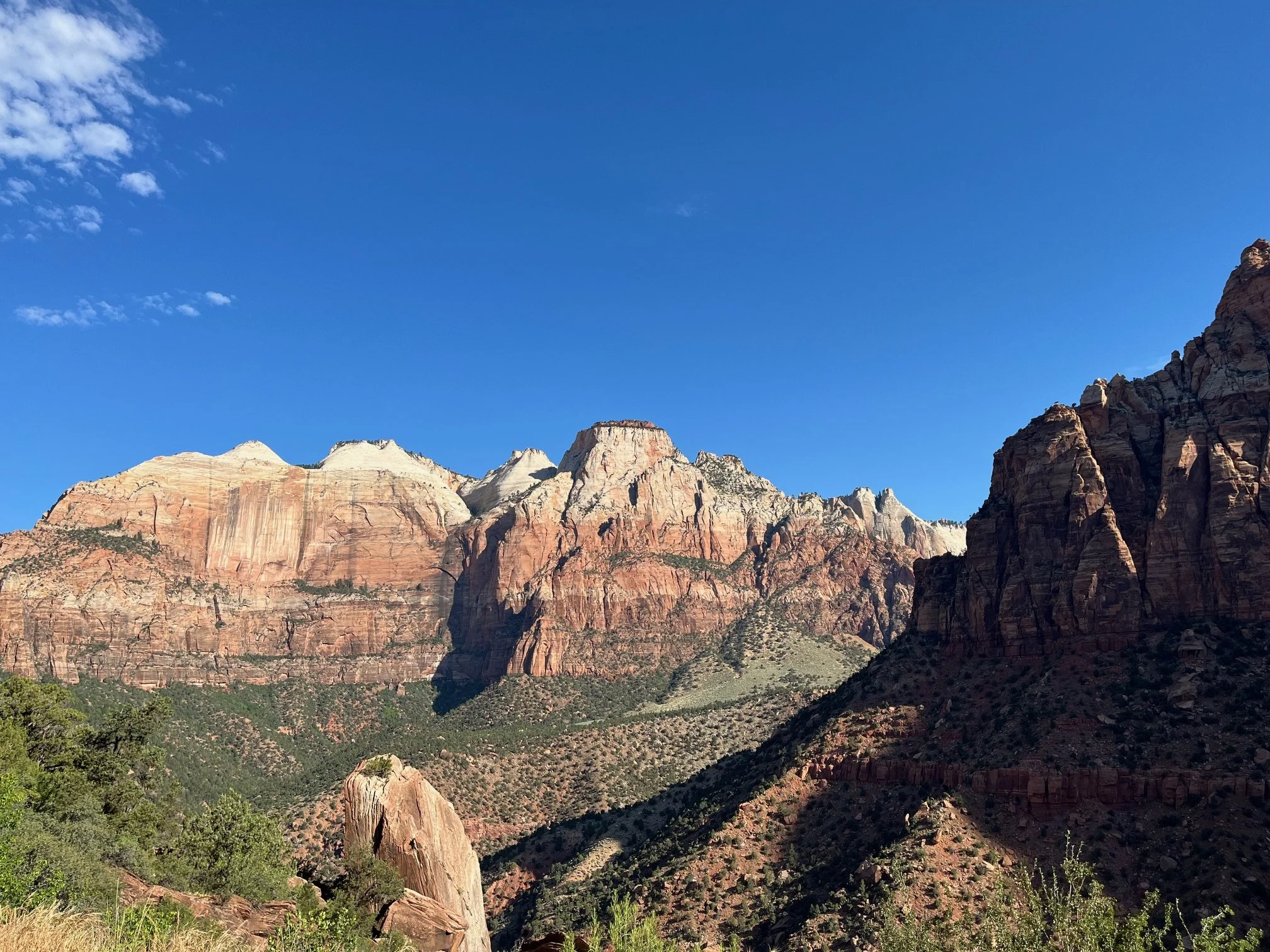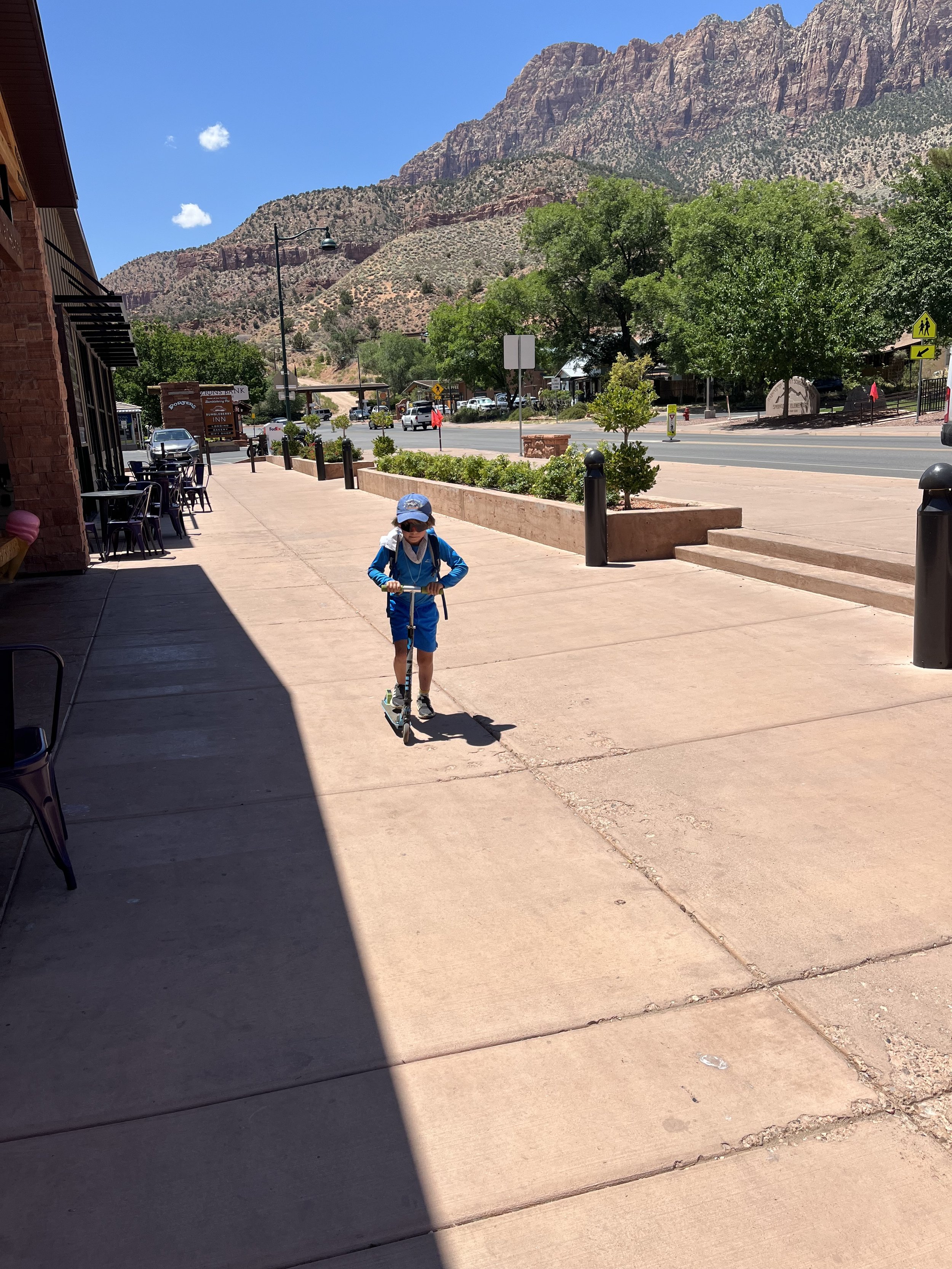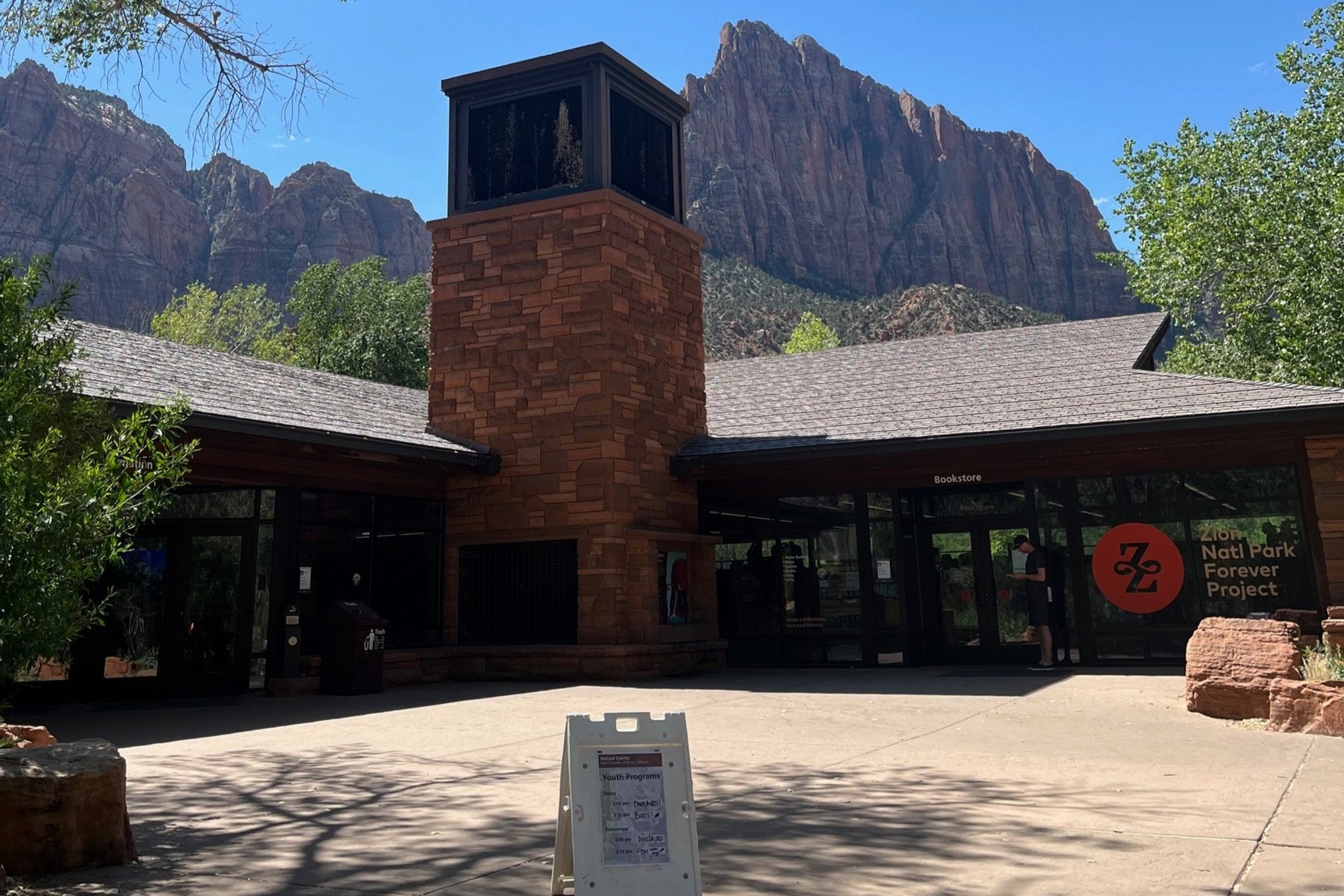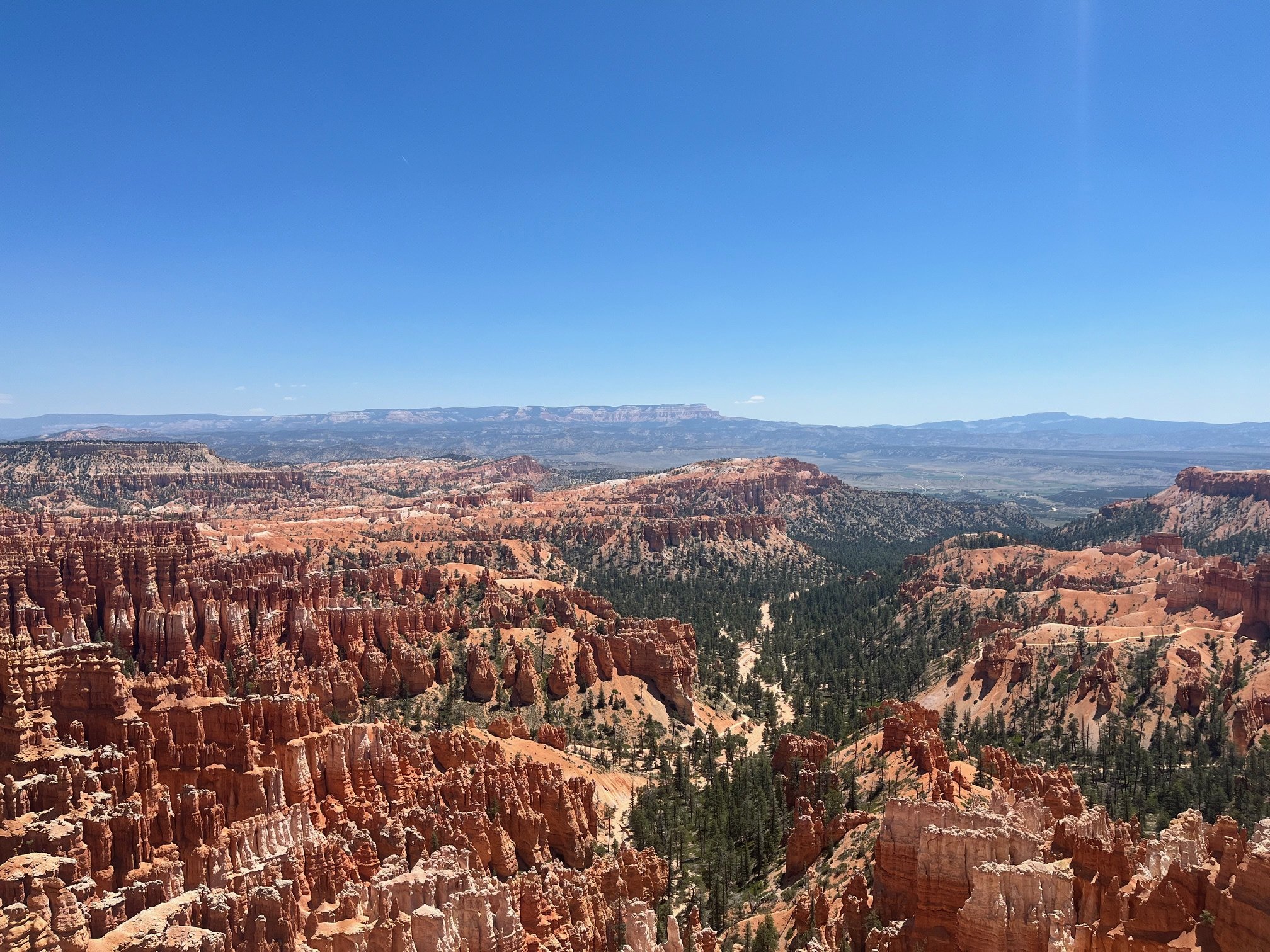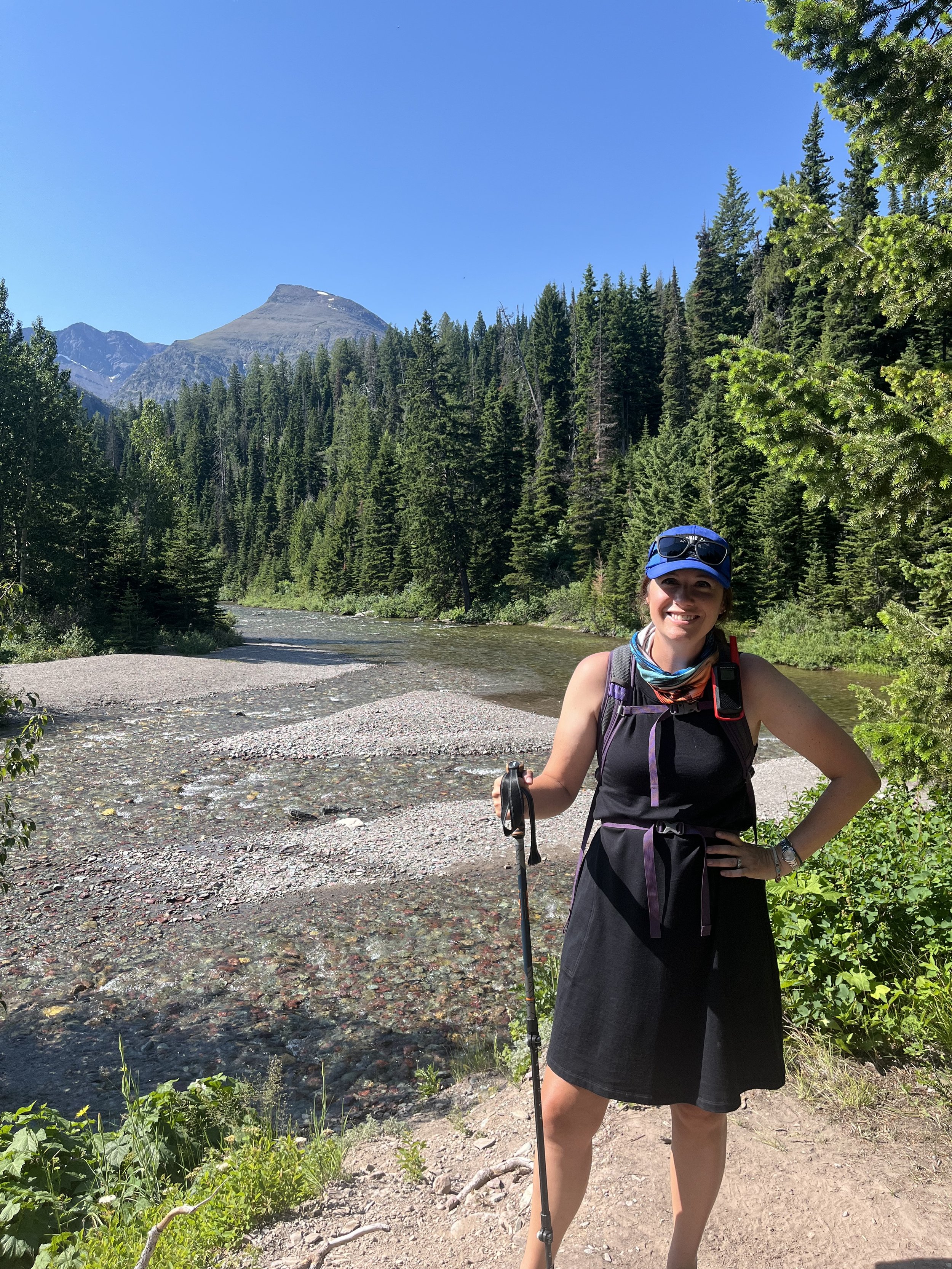Zion National Park vs. Bryce Canyon National Park: Which Should You Visit?
Zion National Park or Bryce Canyon National Park: which of these incredible Utah national parks is right for your next outdoor vacation?
Both destinations are incredible with postcard perfect landscapes, a wide range of hiking and other outdoor adventures, and options for camping and hotel accommodations.
Both parks are within a 4 hour drive from Salt Lake City, making them remote enough to feel a bit wild but still close enough to major airports and amenities.
Zion is best known for its unique and challenging hikes like The Narrows and Angel’s Landing, while Bryce Canyon has thousands of hoodoos and long range views of the Paugansant Plateau and beyond.
My family loves both of these parks—and I think you should visit both, if possible.
But, if time is limited and you can only do one, you’ll be able to learn more about each national park below to find the best fit for your trip to Utah.
Zion National Park vs. Bryce Canyon National Park: pros, cons, and much more!
This post contains affiliate links. If you purchase through one of the links below, I will receive a commission at no charge to you.
Zion vs. Bryce Canyon: An Overview
Given that Zion and Bryce Canyon National Parks are within a 2 hour drive of one another, you’d think that you’d get essentially the same thing at both.
But, thanks to the fascinating geography of Utah, you can drive 20 minutes in one direction, and it will look completely different—so you can imagine what a 2 hour drive can do!
Zion National Park is known for its towering red and orange cliffs that rise up on either side of the Virgin River. Unlike at Grand Canyon National Park, where most of the visitor activity is on the rims of the canyon, you’ll spend a lot of your time at Zion on the canyon bottom.
Zion’s most famous (and most visited) area is Zion Canyon, which is easily accessible from Springdale, Utah. There’s also the Zion-Mt. Carmel Highway, which connects Zion Canyon to East Zion; this is accessible from both Springdale and Kanab.
The least visited area of Zion National Park is Kolob Canyon, which can only be accessed from I-15, which is about an hour’s drive from Springdale.
Bryce Canyon National Park is much more straightforward with the one main entrance that allows visitors to access the hoodoo-filled amphitheatres, multi-purpose biking and hiking trail, and the Southern Scenic Drive.
There is one small section of the park that cannot be accessed from this main entrance, and that’s about 7 miles from the visitors center on Utah’s Scenic Highway 12. This is where the Mossy Cave hike is located.
Both are a part of the Mighty 5 national parks in Utah, which offer up some of the most incredible landscapes in the entire United States.
Check out my complete Utah Mighty 5 road trip with kids post here, and get hiking, camping, dining, and driving suggestions for a complete family vacation.
Highlights of Zion National Park
Part of the Zion Canyon area from the Zion-Mt. Carmel Highway
If you’re thinking about visiting Zion National Park, it’s important that you have a strong understanding of the park’s features, available hikes, and most famous spots.
Doing so will help you better weigh this park against Bryce Canyon National Pqrk to determine if it’s the right fit for your vacation.
Location of Zion
The main entrance to Zion National Park via Zion Canyon is located directly next to Springdale, Utah, with easy access to Hurricane and La Verkin, Utah, which are bigger.
Springdale is about 45 miles from Interstate 15.
Zion National Park is located about 2.5 hours from Las Vegas and a little over 4 hours from Salt Lake City. It is wedged down in the southwestern area of the state, and there’s much more to do here outside of the national park.
For example, you can visit the ghost town of Grafton just a few miles south of Springdale and go hiking and adventuring in Kanab and Coral Pink Sand Dunes State Park.
Annual Visitor Numbers and Reservations
PIN ME!
Zion National Park routinely makes it into the top 5 most visited parks list each year, thanks to the millions of visitors who come from around the world to see the gorgeous canyons, sparkling Virgin River, and famous trails.
It is the most visited of the Utah Mighty 5 national parks, and regularly sees more then 4.5 million people walk or drive through the entrance gates.
Despite the crowds in peak season, Zion National Park has (so far) resisted entrance and vehicle reservations like what you’ll find at Arches National Park or Glacier National Park.
There are vehicle restrictions in place, in that you cannot enter the park in a car when attendance is at its highest.
You can access it via the pedestrian entrance near Zion Village anytime.
Additionally, any time that the shuttle busses are running, you cannot drive a car in the park on Zion Canyon Road between the end of the Pa’Rus Trail and the Temple of Sinawava.
There’s no much you can do to avoid these restrictions other than arriving early to the parks, but at least you don’t have to stress about making specific reservations on days and times of arrival.
Must Do Activities in Zion
Scenic Zion-Mt. Carmel Highway
Inside the historic Zion-Mt. Carmel Tunnel
The Zion-Mt. Carmel Highway is an easy way to get the scope of Zion Canyon. This 2-lane highway connects Springdale to East Zion via the historic Zion-Mt. Carmel Tunnel.
The tunnel is an engineering marvel and worth driving the highway on its own. Built in the late 1930s, this 1.1 mile tunnel was blasted through solid rock in order to bring in visitors from nearby Kanab and make Zion more accessible from Bryce Canyon National Park.
You’ll get access to this area of the park with your regular admission fee, so take the time to add it into your itinerary.
Make the most of your drive on the Zion-Mt. Carmel Highway and elsewhere in the park with the excellent Zion National Park tour from GuideAlong. These inexpensive audio guides provide important context to what you’ll see in the park, and they will start and stop as you approach each point of interest.
Plus, the Zion National Park guide is even more of a value since it also includes an audio tour of Bryce Canyon!
Visitors center
The Zion National Park visitors center near Springdale, Utah
The Zion National Park visitors center is beautiful and has everything you need to start your adventure.
If you’re planning to get a permit for backcountry hiking or Angel’s Landing, there’s a dedicated desk for those.
For general questions, signing up for the free Ride with a Ranger tour, weather information, or hiking suggestions, there’s a separate desk there. This division keeps the line on both shorter and continually moving.
You’ll also find a huge bookstore and gift shop, where you can purchase maps, mugs, t-shirts, stickers, and much more. There’s also a huge kids’ section with books, clothing, backpacks, water bottles, and stuffed animals.
Just outside of the visitors center are bathrooms and a water refill station. There are informational placards surrounding the visitors center under a series of pergolas where you can learn more about the founding of the park, wildlife you might see, and geology of the area.
Camping
The national park has 2 campgrounds on property. The Watchman Campground and the South Campground are on either side of the visitors center near the front of the park.
While the sites are extremely convenient for catching the shuttle and accessing the national park, there are limited site amenities. Tents and smaller self-contained trailers and RVs can use these lots.
Just across the Virgin River from the Watchman Campground, and just outside of the national park’s boundaries is the Zion Canyon Campground and RV Resort, which is a great alternative if the park campgrounds are full, if you have a larger RV or trailers, or you want full hook-ups.
>> Check out my full review of the Zion Canyon Campground and RV Resort here. <<
Biking
The Camping Kiddos, my dad, and I on our e-bikes in Zion National Park
I think that renting e-bikes might be the biggest travel hack for Zion!
Not only do you get to skip the shuttle lines entirely, but you have more freedom to move within the Zion Canyon area of the park.
We visited most recently in mid-June, when temperatures and crowds really begin to climb, but, thanks to our e-bikes, my kids, my dad, and I were able to zip around to trailheads easily.
Of course, renting the e-bikes is more expensive than taking the free park shuttle, but, for once, I’m advocating for the more expensive option.
A visit to Zion National Park is fairly expensive anyway, so you want to make the most of your time here. Renting an e-bike helps you save time and reduce stress, which made the extra expense more than worth it for my family.
For more information on biking in Zion National Park, including your experience on e-bikes vs. pedal bikes, biking trail options, and recommended e-bike rental spots, check out my complete guide.
Playing in the Virgin River
If there’s water nearby, you can guarantee my children will be in it!
The Virgin River is best known for being the location of The Narrows hike, but this pretty river runs throughout the national park.
There are multiple areas where you can easily access the river for some splashing about:
Across from the Temple of Sinawava shuttle stop (stop #9)
Along the Pa’Rus Trail near the Nature Center (there’s even a rope swing in this area!)
Behind the visitors center along the bike path on the way to the pedestrian entrance
At the back of the Watchman Campground (also accessible from the opposite river bank in the Zion Canyon Campground and RV Park)
Playing in the river is just one of the many things to do in Zion National Park besides hiking, so check out that guide for more ideas.
Canyoneering
If you want a bit more adrenaline in your Zion experience, try a canyoneering tour!
Thanks to the many slot canyons in this area, Zion National Park is an incredible place to try canyoneering for the first time.
If you’re not already very well versed in the sport, I’d recommend taking a guided tour. The knowledgeable guides can provide equipment and helpful tips, and they know the best places to go for those interested in learning.
This canyoneering tour in East Zion is great for kids 10 and up and includes orientation, transportation, equipment, and multiple rappels.
Hiking in Zion
My son on the Kayenta Trail
Zion National Park has a couple of the most famous hikes in America, namely Angel’s Landing and The Narrows.
While Angel’s Landing requires a permit and some pre-planning—and isn’t for the faint of heart—The Narrows is open to all visitors, and is an excellent way to cool down on a hot summer’s day.
You’ll need to watch for inclement weather on both of these famous hikes: Angel’s Landing is largely exposed, while the Narrows takes place completely in a slot canyon which can flash flood.
Still, on a beautiful day, you’ll see why people come from across the globe just to experience these two hikes.
If you have little ones in tow, I’d skip Angel’s Landing, but you can absolutely do The Narrows with kids!
Ready to take on the Narrows hike!
Because of Zion’s topography, many of the hikes in the national park have some elevation gain, but the Narrows and the adjoining Riverside Walk are some of the flattest.
Elsewhere in the park, the Kayenta Trail is a fun option that runs from the Grotto (shuttle stop #6) to the Emerald Pools.
You’ll get beautiful views of the canyon and Virgin River as you slowly ascend to the level of the Middle Emerald Pool.
Another short but incredible trail is the Canyon Overlook Trail in East Zion. Parking can be rough for this trail during peak season, but if you can nab a spot, this trail is well worth your time.
Highlights in Bryce Canyon National Park
So many hoodoos, so little time
Filled with thousands of hoodoos, seemingly endless views of the Paunsangunt Plateau, and even a desert waterfall, Bryce Canyon National Park is well worth the trouble of getting to.
The main entrance to the park is where you’ll find most of the visitors, who flock here to see the hoodoo-filled amphitheatres, Southern Scenic Drive, and hiking and biking opportunities.
There’s also a smaller section of the park that’s off of Scenic Highway 12 between Tropic, Utah, and Bryce Canyon City, and this includes the Mossy Cave Trail and beautiful Tropic Ditch Falls.
Visit both for the most complete experience in the park.
Even if you only have 1 day at Bryce Canyon, you can still see many of the park’s iconic areas.
Location of Bryce Canyon
Bryce Canyon National Park is also located in southwest Utah, and about 85 miles from Zion National Park.
Bryce Canyon is about an hour from the closest interstate (I-15), which makes it less accessible than Zion, and thus, less visited.
This is one of those cases where getting off of the beaten path comes with some high rewards, as this part of Utah is best seen off of the interstate.
Besides Bryce Canyon National Park, you’ll also find in this same area Kodachrome Basin State Park, Dixie National Forest, the Old West town of Panguitch, Butch Cassidy’s homestead, and Cedar Breaks National Monument. Capitol Reef National Park is just 2.5 hours northeast via the incredible Scenic Highway 12.
Annual Visitor Numbers and Reservations
While Bryce Canyon National Park is the second most visited national park in Utah, its 2.5 million visitors doesn’t feel quite as impressive when you realize that’s nearly half of what Zion (as the most visited Utah park) receives.
It’s still popular, especially in the summer months, but it hasn’t reached the stratospheric popularity level that Zion currently has.
The majority of visitors are concentrated in the Bryce Amphitheatre area of the park, which is located between the visitors center near the main entrance and Inspiration Point. This area of the park is accessible via the free shuttle, which I highly recommend using during peak season.
Read my complete guide to the Bryce Canyon shuttle system here.
Must do activities in Bryce Canyon
Southern Scenic Drive
If you only have a few hours in this area, the scenic drive through Bryce Canyon is what you’ll want to do!
You’ll be able to stop to see multiple overlooks packed with hoodoos, a natural bridge, and incredible long range views from Yovimpa Point and Rainbow Point.
The scenic drive meanders 18 miles from the entrance, and there is plenty of parking at each of the overlooks.
Visitors Center
My son playing in the prairie dog exhibit at the Bryce Canyon National Park visitors center
This beautiful visitors center is also one of the larger ones we’ve been to, and it has a large ranger information desk, gift shop, and interpretive area.
The gift shop has shirts, kids’ books, key chains, and more, and, on nice days, a second outdoor shop will open up under the tents near the visitors center entrance.
The interpretive area is one not to be missed. Here, you’ll learn about the geology, native peoples, history, and areas of the park through multiple hands-on and interactive exhibits. My kids loved the prairie dog area, where they could pretend to crawl through kid-sized tunnels, and the night sky projection room, where they learned about light pollution.
Don’t forget to see the dinosaur skull by the restrooms, which are to the left as you enter the visitors center!
Overlooks
There are SO many overlooks at Bryce Canyon National Park, which is great for families who aren’t into hiking or visitors with mobility challenges. The reason that Bryce Canyon has the number of overlooks that it does comes from the fact that the main area of the park is located along a ridge.
The amphitheatres with the park’s famed hoodoos are on the left side of this ridge, and there are many opportunities to see them. The most popular overlooks for the hoodoos are in the Bryce Amphitheatre area of the park along the Rim Trail, and include Sunset Point, Sunrise Point, Inspiration Point, and Bryce Point.
Elsewhere along the Southern Scenic Drive, the Natural Bridge, Farview Point, and Yovimpa Point are worth a stop if you’re in a rush. But, honestly, every one of the viewpoints in the park has a unique perspective on this incredible landscape.
Camping
If you’d like to camp inside of Bryce Canyon National Park, you’ll have 2 choices: North Campground near the visitors center and Sunset Campground near Mile 3 on the Southern Scenic Drive.
Both of these are incredibly convenient to everything inside of the park. However, the Sunset Campground is closed in the winter, and only 1 of the loops in the North Campground are open in the winter.
There are also limited hook-ups and amenities within the park campgrounds, so you’ll need to camp either in a tent or in a smaller trailer.
If you’ve got a larger RV or travel trailer, or want full hook-ups, I highly recommend the Bryce Canyon R Journey campground in Cannonville, about 15 minutes outside of the main park entrance.
For more details comparing your options in and out of the park, as well as similar comparisons for camping in all of the Utah Mighty 5 parks, check out my guide to the best RV camping in the Utah national parks here.
Biking
Biking inside Bryce Canyon National Park
Bryce Canyon is an excellent place to bike ride as there is an 18-mile long multi-use trail that runs from Bryce Amphitheatre in the park past the visitors center through Bryce Canyon City and out towards Red Canyon in Dixie National Forest.
You can rent bikes in Bryce Canyon City, but there is also a convenient bike rental station in the historic service station near the Bryce Canyon Lodge.
For the most part, the multi-use trail here is flat and easily accessible on a pedal bike. If time is of the essence, and you’re biking more for transportation than for sightseeing, an e-bike might still come in handy.
For more information, including rental location suggestions, tips on biking with kids and more, see my biking in Bryce Canyon National Park guide.
Hiking in Bryce Canyon
At the Tropic Ditch Falls on the Mossy Cave Trail
Bryce Canyon National Park has some excellent hiking options at a variety of difficulty levels, making this a great outdoor destination for any ability level.
Easy hikes include the Bristlecone Loop Trail at Mile 18 on the Southern Scenic Drive, and the Mossy Cave Trail off of Scenic Highway 12.
The Rim Trail is largely flat, but includes awe-inspiring views of the park’s hoodoos in the Bryce Amphitheatre area. The entire Rim Trail runs 11 miles, but you can easily pick and choose a smaller section if you don’t have the time or motivation to do the entire thing.
If you’d like to get up close to the hoodoos, Queen’s Garden Trail (1.8 miles) and Navajo Loop Trail (1.3 miles) are your best bets. These are also the most popular hikes in the park, so be prepared to see others if you’re visiting during the summer.
Which Utah national park is better for kids?
Having visited both of these parks with my kids (and all of the other Utah national parks!), I am happy to report that both make for excellent family vacation destinations.
Ultimately, it comes down to what your family likes to do and when you’ll be visiting.
If you’re more into red rock canyons, splashing in rivers, and deserts, Zion National Park is the way to go. There are plenty of kid-friendly trails here, as well as a Nature Center, a Junior Ranger program, and family friendly, free ranger talks.
Additionally, Springdale has plenty to do with shopping and dining options for when your family is ready for a break from the park.
Learn more about visiting Zion National Park with kids in my complete guide.
Bryce Canyon National Park, on the other hand, has a mixture of desert and forest, which provides a wider range of hiking options.
There are the aforementioned kid-friendly trails like Mossy Cave, the excellent visitors center, the Hike the Hoodoos program, the free bus shuttle, and the Junior Ranger program.
There’s also so much to do if you venture outside of the park a little, including the kid-friendly Kodachrome Basin State Park (where kids can rent archery equipment or find treasures in a pretend paleontological dig!), riding ATVs in Dixie National Forest, and exploring the quaint Old West Town of Panguitch.
Learn more about visiting Bryce Canyon National Park with kids in this guide.
Which is better for hiking: Zion or Bryce Canyon?
Zion National Park has the 2 more famous hikes—Angel’s Landing and The Narrows—but the hiking at Bryce Canyon National Park is worth your time if you’re interested in trails through unique geological formations.
Ultimately, Zion National Park has a wider variety of trails, which is why it attracts so many hikers. Between the 3 areas of the park, you can do a hike completely in the water (The Narrows), hike along canyon ridges (Angel’s Landing and West Rim Trail), do hikes with spectacular scenery (Canyon Overlook Trail), and hiking in unique rock formations (The Subway in Kolob Canyon).
Bryce Canyon’s many trails center around the park’s hoodoos, which is why I encourage you to complete the Hike the Hoodoos program if you visit!
Is Zion or Bryce Canyon better to visit in the summer?
Bryce Canyon and the surrounding area is located on the Paunsaugunt Plateau, so it is much higher in elevation than any of the other 4 Utah national parks. Thanks to this elevation, the park stays cooler year round, making it an excellent summer travel destination.
Zion National Park, on the other hand, sees soaring temperatures between late May and early September, and hiking here in the summer can be downright unsafe mid-day.
For a complete look at what visiting Zion National Park in the summer look like, check out my guide.
If you have to visit one of these in the summer, make it Bryce Canyon National Park, which is warm (but not blazing) during the day, and breezy at night.
If you do have to visit Zion in the summer, go very early in the morning to do your hikes, stay out of the sun from 11 AM-5 PM (when temperatures can climb to 100 degrees or more!) and drink water constantly.
What to bring to Zion and Bryce Canyon
Both of these parks are fairly remote, though Bryce Canyon National Park is more so. Here’s what I would plan ahead and bring into both of these parks.
Food and snacks
While Zion National Park does have Springdale, Utah, at its main entrance, the grocery stores you’ll find there are going to be small and much more expensive than you’ll find at a larger town elsewhere in Utah.
When we were heading into Zion National Park, we stopped in Cedar City to fill up on groceries, but you can also find big box stores in Hurricane or St. George.
Over in Bryce Canyon City, you will find just a small selection of groceries inside of Ruby’s Inn; these are marked much higher than at a traditional store.
The other option you’ll have is in Tropic, Utah, about 10 minutes from Bryce Canyon City, where you can shop at Clark’s Country Market.
While Clark’s has a much bigger selection than the market at Ruby’s Inn, you’ll still pay a premium. For example, instead of being able to buy a tray of fresh chicken breasts, you can only buy them individually wrapped—but for the same price you’ll pay for the entire tray at a regular grocery store.
While we did have to stop by Clark’s for some staples and snacks during our visit to Bryce Canyon, we made sure to stock up on meats, most of our meals, and drinks beforehand.
Part of the picnic area at the Grotto in Zion National Park
Cooler
To help with your food and drinks, be sure to pack a cooler with ice before you head into the park.
Not only does this open up new options for snacks and meals, but you’ll also have the best treat of all after a hike: an icy cold drink.
If you need to buy a cooler bag, you can find one in Springdale at Sol Foods Supermarket on Zion Park Boulevard, or at Clark’s Country Store in Tropic, Utah.
Hiking day pack
Stay hydrated with snacks on hand with a hiking day pack. Even if you plan to stick to some of the shorter hikes in the park, you’ll want to ensure that you have a good day pack that you can take with you.
If you did manage to wander off trail, you’ll want to ensure that you have your food, water, and GPS with you.
I have an Osprey Daylight that I use for my day pack, which works well for shorter hikes. I carried that bag with me throughout our most recent visits to both Zion and Bryce Canyon, and it worked well.
It’s big enough to put all of the things that the kids and I need during a hike (our Garmin Inreach Mini, snack bars, cell phone, first aid essentials), but small enough to be lightweight for a shorter day hike.
Extra water
If you plan to take a hike in either of these parks especially in the summer, please (please!) take at least twice the amount of water you think you’ll need. Zion, in particular, gets super, super hot, but both parks are in arid climates.
Your hiking pack should include a water bladder; fill it up before you leave for your hike. A 2-2.5L water bladder should work for most people for a day hike, but anticipate your specific needs.
Keep cold water in your cooler in the car for additional resources.
There are areas in both Zion and Bryce Canyon to fill your water in/near the visitors centers. Beyond that, water is scarce, so come prepared.
Zion National Park has a water bottle refill station at the Grotto bathrooms (shuttle stop #6). Bryce Canyon has an additional refill station near Rainbow Point and Yovimpa Point at Mile 18 on the Southern Scenic Drive.
Hiking shoes
Other than the paved Pa’Rus Trail at Zion National Park, you are going to be hiking on a combination of sand and rock in both of these parks.
Tennis shoes are not going to be able to provide the appropriate grip on the slick rock scrambles, and flip flops are even worse.
When hiking in the summer, in arid climates, or in the desert, I prefer to wear my Keen Newport H2 hiking sandals, which have a closed toe and back strap, but holes along the side for ventilation.
Hat
Desert hiking is one of my favorite outdoor activities, but it’s also brutal during the warmer months. Unlike hiking in a forest, where there’s a tree canopy to help block some of the direct sunlight, desert hiking means that you have no relief from the sun.
There simply aren’t trees that grow large enough out here to provide any real shade, so you’ll need to bring your own. I recommend a wide brimmed sun hat or a baseball cap to help protect your scalp, ears, and face from the sun while hiking in both Zion and Bryce Canyon.
Final Thoughts on Zion vs. Bryce Canyon
You cannot go wrong at either of these incredible parks, so whichever you choose is going to make for an excellent vacation destination.
Zion National Park is closer to major airports (just 2 hours from Las Vegas and 3.75 hours to Salt Lake City), but it sees record numbers of visitors each year. You’ll have to balance that convenience with planning a visit at the right time of year to navigate around those crowds.
Zion is also much, much hotter in the summer months, adding another layer of planning consideration.
Zion’s incredible hiking is what keeps visitors pouring in from all over the world so they can experience unique trails like The Narrows, Angel’s Landing, the Kayenta Trail, and more.
Yet, Zion’s closest town, Springdale, is an adorable destination unto itself with many excellent restaurants, shops, hotels, campgrounds, and even a few small grocery stores.
On the other hand, Bryce Canyon National Park, thanks to its higher elevation, is much nicer during the summer. Despite it being the second most visited Utah national park, Bryce Canyon sees about half as many visitors as Zion does, so it doesn’t feel super busy even at its peak visitation times.
The hoodoos here are awe-inspiring, but you will need to be okay with hiking down into the amphitheatre to see them up close.
Bryce Canyon’s closest town, Bryce Canyon City, is tiny and doesn’t offer as many amenities, stores or restaurants as Springdale. You’ll need to head over to Cannonville to get some (overpriced) groceries.
Ultimately, Zion is well worth a visit for the once-in-a-lifetime hikes and gorgeous canyon views, while Bryce Canyon is an excellent destination if those who want to get away from it all while experiencing a unique landscapes and cooler temperatures.
